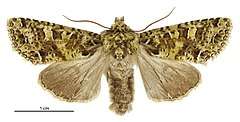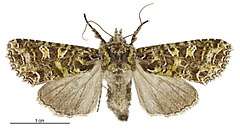Graphania tetrachroa
Graphania tetrachroa is a species of moth of the family Noctuidae. This species is endemic to New Zealand. It is classified as "Data Deficient" by the Department of Conservation.
| Graphania tetrachroa | |
|---|---|
 | |
| Male | |
 | |
| Female | |
| Scientific classification | |
| Kingdom: | |
| Phylum: | |
| Class: | |
| Order: | |
| Family: | |
| Genus: | |
| Species: | G. tetrachroa |
| Binomial name | |
| Graphania tetrachroa | |
| Synonyms[2] | |
| |
Taxonomy
It was described by Edward Meyrick in 1931 from a female specimen collected by George Hudson at Waimarino National Park on 6 January 1930 and named Melanchra tetrachroa.[3][4] Hudson discussed and illustrated this species under that name in his 1939 Supplement to the Butterflies and Moths of New Zealand.[4] In 1971 John S. Dugdale transferred species in the genus Melanchra to Graphania.[5] The holotype specimen is held at the Natural History Museum, London.[2]
In 2017 it was explained that Graphania tetrachroa (Meyrick, 1931) may possibly be composed of two separate species.[6] These are the described species G. tetrachora, known only from the type specimen mentioned above, and a species, currently undescribed but known as "Graphania" cf. tetrachroa, classified as Nationally Vulnerable by the New Zealand Threat Classification System.[6] The reasoning given for this separation were the differences in wing pattern between the two entitles as well as the lack of variability in the known series of G. cf. tetrachroa.[6] It was also argued that both entities belong in the genus Meterana but have yet to be moved to this genus.[6] It is possible that further taxonomic work may show that these two entities belong to the same species.[6]
Description
The larvae are brown-orange in colour and are mottled black or grey.[7]
Meyrick originally described the adult female of the species as follows:
♀ 37 mm. Head dark grey, mixed light greenish. Palpi, pale greyish-ochreous, with three blackish bars, projecting scales of second joint grey. Thorax, dark grey mixed black, crests and tegulae except margins moss-green. Forewings rather elongate-triangular, termen rather obliquely curved, crenate; ashy-grey, ground colour largely obscured by moss-green and black markings; a green subcostal streak from base to 5⁄6 with several black transverse marks, costal edge above this posteriorly blackish with three whitish dots; basal third green except on veins, with two oblique black streaks beneath cell near base, beyond these a small spot of pale brownish edged posteriorly by a blackish mark, just above dorsum a strong black longitudinal streak edged white beneath; dorsal edge pale ochreous-brown throughout, marginal scales whitish; first line curved, green, edged black posteriorly, interrupted on veins; oblique-oval orbicular and curvedtransverse reniform green, very finely whitish-edged, united by a trapezoidal deep black blotch, and externally black-edged with adjacent spaces mixed green and black; claviform represented by a rounded black blotch mixed green resting on first line; second line green and whitish, edged black anteriorly, interrupted on veins, angulated above and bidentate below middle, followed by a green fascia interrupted on veins; subterminal line forming three nearly straight segments united by light ochreous-brown spots, two lower white strongly edged black suffusion, upper represented by thick blackish anterior margin and a pale green blotch extending to apex; a terminal series of black crescentic marks preceded by green spots; cilia pale greenish. Hindwings grey; an interrupted dark grey terminal line; cilia, grey whitish, a grey subbasal line round upper part of termen.[3]
Distribution
The species is endemic to New Zealand.[1][2] It is known from Pureora and National Park down to Southland.[7] Along with the type locality, this species has also been collected at Kaimanawa Forest Park near Lake Taupo.[8]
Biology and behaviour
The larvae of this species feed on the foliage of their host plants.[7] The larvae pupate by February.[7] The adults of this species are on the wing in January and February.[4][8] The adult moths are nocturnal.[7] This species has been collected using sugar and light trapping.[4][8]
Host species and habitat
The host species for the larvae of this moth are Olearia species including O. odorata, O. hectorii and O. fimbriata.[7]
Conservation status
In 2017 this species was classified as having the "Data Deficient" conservation status under the New Zealand Threat Classification System.[6] In that document the species was treated as two separate entitles.[6] Graphania tetrachroa (Meyrick, 1931) was classified as "Data Deficient" and "Graphania" cf. tetrachroa was classified as "Nationally vulnerable".[6]
References
- "Graphania tetrachroa (Meyrick, 1931)". www.nzor.org.nz. Landcare Research New Zealand Ltd. Retrieved 2017-07-08.
- Dugdale, J. S. (1988). "Lepidoptera - annotated catalogue, and keys to family-group taxa" (PDF). Fauna of New Zealand. 14: 205. ISSN 0111-5383. Retrieved 9 July 2017.
- Meyrick, Edward (30 September 1931). "New Species of New Zealand Lepidoptera". Transactions and Proceedings of the Royal Society of New Zealand. 62: 92–97 – via National Library of New Zealand.
- Hudson, G. V. (1939). A supplement to the butterflies and moths of New Zealand. Wellington: Ferguson & Osborn Ltd. pp. 399–400. OCLC 221041540. Retrieved 31 May 2018.
- Dugdale, J.S. (1971). "Entomology of the Aucklands and other islands south of New Zealand: Lepidoptera, excluding non-crambine Pyralidae" (PDF). Pacific Insects Monograph. 27: 55–172.
- Hoare, R.J.B.; Dugdale, J.S.; Edwards, E.D.; Gibbs, G.W.; Patrick, B.H.; Hitchmough, R.A.; Rolfe, J.R. (2017). "Conservation status of New Zealand butterflies and moths (Lepidoptera), 2015" (PDF). New Zealand Threat Classification Series. 20: 8.
- Patrick, Brian (2000). Lepidoptera of small-leaved divaricating Olearia in New Zealand and their conservation priority (PDF). Wellington, N.Z.: Department of Conservation. pp. 10, 19. ISBN 0478220154. Retrieved 1 June 2018.
- "Graphania tetrachroa". www.AucklandMuseum.com. 22 November 2002. Retrieved 31 May 2018.
External links
| Wikimedia Commons has media related to Graphania tetrachroa. |
| Wikispecies has information related to Graphania tetrachroa |